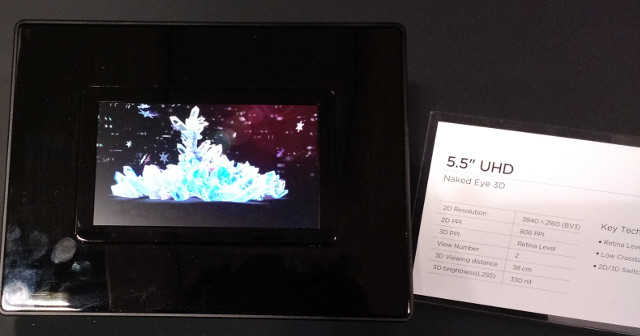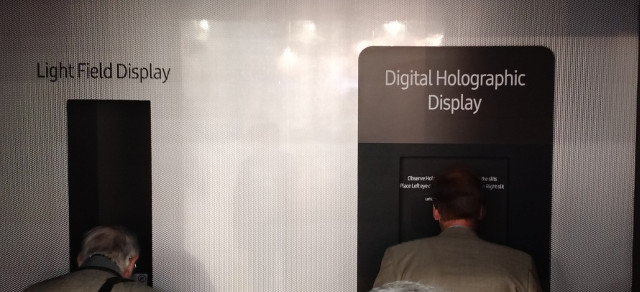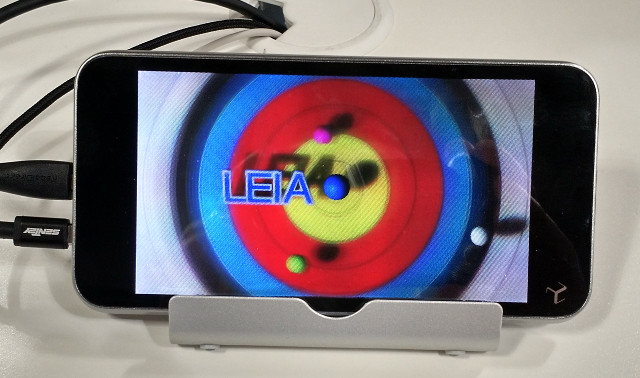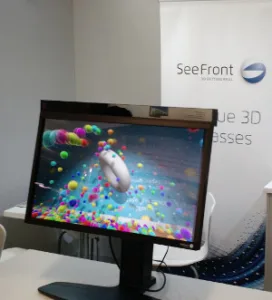At SID DisplayWeek in San Francisco, there were several demonstrations of 3D technology on the show floor, which we summarize below. We did not review any papers, however.
SeeFront is a German company developing monitors for glasses-free 3D viewing. They were at SID last year and this year we asked for an update. Not too much was new for their 24” monitor which has UHD resolution. The frame rate was increased from 30 to 60 fps and they were showing a new eye tracking solution. The new solution was being developed to reduce latency, but it was not as robust and stable as the previous version as it had a hard time locking on and tracking my eyes with even small head movements. The depth volume is modest, but the high resolution makes for a pretty crisp 3D image.
They are also working on an iPad app that will allow the easy editing of 3D models and the creation of stereo pairs for display on the monitor.
BOE was showing two different glasses-free 3D displays. One was a 5.5” LCD device that offered UHD resolution (806 ppi) and what appeared to be a lenticular optical layer on top. It was a two-view display with 3D brightness of 330 cd/m². Performance was terrible.
The 10.1” prototype was based upon OLED technology and offered the same UHD resolution (436 ppi) and 125 cd/m² of brightness in 3D mode. It is also a two-view device using their X-view technology, which was not explained. This looked just as bad with no depth and was just plain strange looking!

Samsung was showing two 3D displays at SID and was drawing lines to see them. One display was called a light field display that was performing like a lenticular-based, which upon asking the representative, is what it turned out to be.
The panel is 10.1’, has a 20-degree 3D viewing angle and 21 views. Performance was just fair with dark bands visible with slight head movement. While they did not confirm that they will add a microlens array next to make it a true light field display, they acknowledged that would be a logical next step.

The holographic did indeed appear to be a true holographic display, although very few details were provided to actually validate that (especially considering the misleading naming of the other display). As their poster indicated, there is a very narrow (2.2-degree) viewing angle so you had to view the image thru two slits in the vertical enclosure. The image was of a butterfly that was placed within a real life flowers in the enclosure behind the slits. The butterfly was tiny (maybe inside a 1” cube), monochrome green and not particularly well defined or bright. The image was not being generated in real time either. In other words, this is a very early prototype, whose development only started last fall. A full color demo is planned for next year with commercialization at least five years out.

A company called Leia was also on the show floor demonstrating their “holographic phone.” This is most definitely not a holographic image – it uses an optical element defined using holographic techniques.
The company is a spin out from HP Labs and occupies a space within the Labs. It recently announced that its display would be used in a phone to be launched by Altice by the end of 2017. Altice says that it will distribute the phone to customers in France, Belgium, Luxembourg, Portugal, Israel and the Dominican Republic.
The LCD display has a base resolution of 1440 x 2560. The 3D effect is created with a holographic grating that sits between the backlight and LCD panel. It has 4 vertical viewing zones and 8 horizontal viewing zone so is clearly differentiated by the ability to show parallax in both direction (all lenticular designs are horizontal parallax only). The viewing cone is said to be 15 degrees horizontally and 15 degrees vertically.

Images are created from 32 virtual cameras, although they provided no details on how this is done and the nature of the source content. A series of shaders are then used to change the opacity to create more compelling images. The rendering engine has the ability to change the inter-ocular distance and the depth volume.
I must say, I was not that impressed with the image quality. The depth volume is very small, maybe +/1 2 inches and I was not able to ever see a clean 3D image – there seemed to be too much overlap with the next view. The viewing angles were also not as wide as claimed.
The design sound intriguing on paper and with more work may yield a more impressive image. -CC (for more on Leia, see our report from the Investors’ Conference – (Leia Uses Diffraction for Lightfields)

